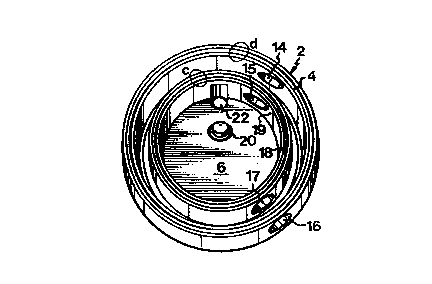Some of the information on this Web page has been provided by external sources. The Government of Canada is not responsible for the accuracy, reliability or currency of the information supplied by external sources. Users wishing to rely upon this information should consult directly with the source of the information. Content provided by external sources is not subject to official languages, privacy and accessibility requirements.
Any discrepancies in the text and image of the Claims and Abstract are due to differing posting times. Text of the Claims and Abstract are posted:
| (12) Patent: | (11) CA 2122375 |
|---|---|
| (54) English Title: | LUMINESCENCE MEASURING SYSTEM AND LUMINOMETER DEVICE |
| (54) French Title: | SYSTEME DE MESURE DE LUMINESCENCE ET LUMINOMETRES |
| Status: | Expired and beyond the Period of Reversal |
| (51) International Patent Classification (IPC): |
|
|---|---|
| (72) Inventors : |
|
| (73) Owners : |
|
| (71) Applicants : |
|
| (74) Agent: | GOWLING WLG (CANADA) LLP |
| (74) Associate agent: | |
| (45) Issued: | 1997-12-16 |
| (86) PCT Filing Date: | 1992-10-29 |
| (87) Open to Public Inspection: | 1993-05-13 |
| Examination requested: | 1994-06-14 |
| Availability of licence: | N/A |
| Dedicated to the Public: | N/A |
| (25) Language of filing: | English |
| Patent Cooperation Treaty (PCT): | Yes |
|---|---|
| (86) PCT Filing Number: | PCT/SE1992/000749 |
| (87) International Publication Number: | WO 1993009420 |
| (85) National Entry: | 1994-04-27 |
| (30) Application Priority Data: | ||||||
|---|---|---|---|---|---|---|
|
A luminescence measuring system comprises means (26) for supplying samples located in separate test tubes (25). In the
measuring chamber of a luminometer, the samples are in turn presented to a light detector, such as a photomultiplier. Two
mutually displaceable components (1, 2), which are cup-shaped and fit into one another with the cup bottoms facing outwards, define
the measuring chamber (5). The component shells are provided with holes (11, 12, 11', 12', 14, 15, 16, 17) which can be aligned by
displacement of the components so as to admit the test tube into the luminometer and the measuring chamber (5) and to
discharge it therefrom under the action of gravity. The test tubes are conveyed to the luminometer by a sleeve-chain conveyor having
a bottom with a through hole.
Un système de mesure de la luminescence comprend des moyens (26) pour la fourniture d'échantillons placés dans des éprouvettes séparées (25). Dans la chambre à mesurer d'un luminomètre, les échantillons sont tour à tour présentés à un détecteur de lumière, comme un photomultiplicateur. Deux composants mutuellement déplaçables (1, 2) en forme de coupelles qui se logent l'un dans l'autre et dont les coupelles font face à l'extérieur, délimitent la chambre à mesurer (5). Les enveloppes des composants ont des trous (11, 12, 11', 12', 14, 15, 16, 17) qui peuvent être alignés en déplaçant les composants de façon à introduire l'éprouvette dans le luminomètre et la chambre à mesurer (5) et à la décharger par gravité. Les éprouvettes sont acheminées au luminomètre par un convoyeur à chaîne à manchons ayant un fond muni d'un trou de passage.
Note: Claims are shown in the official language in which they were submitted.
Note: Descriptions are shown in the official language in which they were submitted.

2024-08-01:As part of the Next Generation Patents (NGP) transition, the Canadian Patents Database (CPD) now contains a more detailed Event History, which replicates the Event Log of our new back-office solution.
Please note that "Inactive:" events refers to events no longer in use in our new back-office solution.
For a clearer understanding of the status of the application/patent presented on this page, the site Disclaimer , as well as the definitions for Patent , Event History , Maintenance Fee and Payment History should be consulted.
| Description | Date |
|---|---|
| Inactive: IPC from MCD | 2006-03-11 |
| Time Limit for Reversal Expired | 2002-10-29 |
| Letter Sent | 2001-10-29 |
| Grant by Issuance | 1997-12-16 |
| Inactive: Application prosecuted on TS as of Log entry date | 1997-10-14 |
| Inactive: Status info is complete as of Log entry date | 1997-10-14 |
| Pre-grant | 1997-08-19 |
| Notice of Allowance is Issued | 1997-04-22 |
| All Requirements for Examination Determined Compliant | 1994-06-14 |
| Request for Examination Requirements Determined Compliant | 1994-06-14 |
| Application Published (Open to Public Inspection) | 1993-05-13 |
There is no abandonment history.
The last payment was received on 1997-09-16
Note : If the full payment has not been received on or before the date indicated, a further fee may be required which may be one of the following
Please refer to the CIPO Patent Fees web page to see all current fee amounts.
| Fee Type | Anniversary Year | Due Date | Paid Date |
|---|---|---|---|
| Final fee - standard | 1997-08-19 | ||
| MF (application, 5th anniv.) - standard | 05 | 1997-10-29 | 1997-09-16 |
| MF (patent, 6th anniv.) - standard | 1998-10-29 | 1998-09-18 | |
| MF (patent, 7th anniv.) - standard | 1999-10-29 | 1999-09-16 | |
| MF (patent, 8th anniv.) - standard | 2000-10-30 | 2000-09-19 |
Note: Records showing the ownership history in alphabetical order.
| Current Owners on Record |
|---|
| PERSTORP ANALYTICAL AB |
| Past Owners on Record |
|---|
| NILS WIHLBORG |